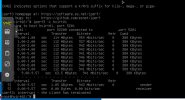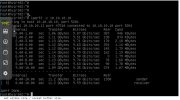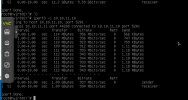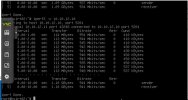hello guys
i followed the video tutorial how to install ceph from the proxmox site. everything went smoth except one thing
the command
rados bench -p ceph-test 100 write --no--cleanup
gives me following result:
Total time run: 101.331
Total writes made: 4030
Write size: 4194304
Object size: 4194304
Bandwidth (MB/sec): 159.082
Stddev Bandwidth: 25.6711
Max bandwidth (MB/sec): 236
Min bandwidth (MB/sec): 40
Average IOPS: 39
Stddev IOPS: 6.41777
Max IOPS: 59
Min IOPS: 10
Average Latency(s): 0.399168
Stddev Latency(s): 0.509006
Max latency(s): 3.98511
Min latency(s): 0.0101132
Cleaning up (deleting benchmark objects)
Removed 4030 objects
Clean up completed and total clean up time :3.35888
159 mb write for ssd ?????
the strange thing if i
the following ssd is in the servers (2x) - mzql23t8hcls
https://semiconductor.samsung.com/ssd/datacenter-ssd/pm9a3/mzql23t8hcls-00a07/
in linux, like on the video shown, the results are following
read: 9.5 GB/s
write: 22.2 GB/s
it would mean 9000 MB reading and 22000 mb write (isnt normally reading faster ???)
i have the impression the performance is not good on the proxmox and its much to slow
how can that be explained ?
what can i do to get the max out ? (i followed exactly the video - so, its pretty much everything standard settings)
thx guys for your input
i followed the video tutorial how to install ceph from the proxmox site. everything went smoth except one thing
the command
rados bench -p ceph-test 100 write --no--cleanup
gives me following result:
Total time run: 101.331
Total writes made: 4030
Write size: 4194304
Object size: 4194304
Bandwidth (MB/sec): 159.082
Stddev Bandwidth: 25.6711
Max bandwidth (MB/sec): 236
Min bandwidth (MB/sec): 40
Average IOPS: 39
Stddev IOPS: 6.41777
Max IOPS: 59
Min IOPS: 10
Average Latency(s): 0.399168
Stddev Latency(s): 0.509006
Max latency(s): 3.98511
Min latency(s): 0.0101132
Cleaning up (deleting benchmark objects)
Removed 4030 objects
Clean up completed and total clean up time :3.35888
159 mb write for ssd ?????
the strange thing if i
the following ssd is in the servers (2x) - mzql23t8hcls
https://semiconductor.samsung.com/ssd/datacenter-ssd/pm9a3/mzql23t8hcls-00a07/
in linux, like on the video shown, the results are following
read: 9.5 GB/s
write: 22.2 GB/s
it would mean 9000 MB reading and 22000 mb write (isnt normally reading faster ???)
i have the impression the performance is not good on the proxmox and its much to slow
how can that be explained ?
what can i do to get the max out ? (i followed exactly the video - so, its pretty much everything standard settings)
thx guys for your input





